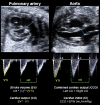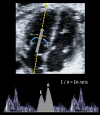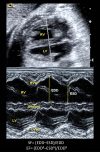Ultrasound assessment of fetal cardiac function
- PMID: 28191192
- PMCID: PMC5030052
- DOI: 10.1002/j.2205-0140.2013.tb00242.x
Ultrasound assessment of fetal cardiac function
Abstract
Introduction: Fetal heart evaluation with US is feasible and reproducible, although challenging due to the smallness of the heart, the high heart rate and limited access to the fetus. However, some cardiac parameters have already shown a strong correlation with outcomes and may soon be incorporated into clinical practice. Materials and Methods: Cardiac function assessment has proven utility in the differential diagnosis of cardiomyopathies or prediction of perinatal mortality in congenital heart disease. In addition, some cardiac parameters with high sensitivity such as MPI or annular peak velocities have shown promising results in monitoring and predicting outcome in intrauterine growth restriction or congenital diaphragmatic hernia. Conclusion: Cardiac function can be adequately evaluated in most fetuses when appropriate expertise, equipment and time are available. Fetal cardiac function assessment is a promising tool that may soon be incorporated into clinical practice to diagnose, monitor or predict outcome in some fetal conditions. Thus, more research is warranted to further define specific protocols for each fetal condition that may affect cardiac function.
Keywords: 4D STIC; echocardiography; fetal cardiac function; myocardial imaging; tissue Doppler.
Figures











References
-
- Carvalho JS, Chaoui R, Copel JA, DeVore GR, Hecher K, Lee W, et al. ISUOG practice guidelines (updated): sonographic screening examination of the fetal heart. Ultrasound Obstet Gynecol 2013; (41): 348–59. - PubMed
-
- Lee W, Allan L, Carvalho JS, Chaoui R, Copel J, Devore G, et al. ISUOG consensus statement: what constitutes a fetal echocardiogram? Ultrasound Obstet Gynecol 2008; 32 (2): 239–42. - PubMed
-
- Rychik J, Tian Z, Bebbington M, Xu F, McCann M, Mann S, et al. The twin‐twin transfusion syndrome: spectrum of cardiovascular abnormality and development of a cardiovascular score to assess severity of disease. Am J Obstet Gynecol 2007; 197 (4): 392. e1–8. - PubMed
-
- Crispi F, Hernandez‐Andrade E, Pelsers MM, Plasencia W, Benavides‐Serralde JA, Eixarch E, et al. Cardiac dysfunction and cell damage across clinical stages of severity in growth‐restricted fetuses. Am J Obstet Gynecol 2008; 199 (3): 254. e1–8. - PubMed
-
- Van Mieghem T, Gucciardo L, Done E, Van Schoubroeck D, Graatsma EM, Visser GH, et al. Left ventricular cardiac function in fetuses with congenital diaphragmatic hernia and the effect of fetal endoscopic tracheal occlusion. Ultrasound Obstet Gynecol 2009; 34 (4): 424–29. - PubMed
Publication types
LinkOut - more resources
Full Text Sources
Other Literature Sources
Medical
